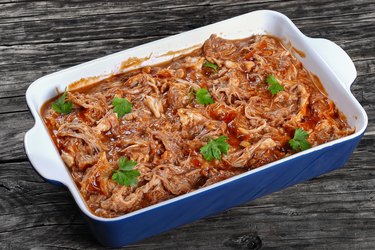
What cut of beef is best for shredding? Not all roasts are equal if your goal is to create tender, juicy shreds of meat. Certain cuts of beef are better for slicing and won't shred no matter how long you roast them. Sort out the roasts to find the best meat for pulled beef for your next meal.
What Makes Good Shredding Beef?
Video of the Day
With so many different cuts of beef, it's confusing to figure out which type to buy for certain recipes. There's no one best cut of beef because the qualities of different cuts are good for different purposes.
Video of the Day
For shredding, you want a beef cut that gets fork tender. It sounds backwards, but the best cuts for this purpose start out tough and are inexpensive. They also have lots of connective tissues and fat in them.
When you cook the best type of beef for shredding, those connective tissues break down under the heat. No matter what cut you choose, look for a roast with lots of marbling and connective tissue for the easiest shredding.
Best Roast for Shredded Beef
So, what is the best roast for shredded beef? The following options are the best meat for barbecue beef and other shredded-meat dishes:
- Chuck roast: This inexpensive cut is sometimes called a blade pot roast since it comes from the neck and shoulder blade area. It has lot of marbling, which creates moist, tender meat that shreds well.
- Beef brisket: Another inexpensive, tough cut that comes out moist and ready to shred is the brisket. This piece of meat from the foreshank will shred after proper cooking for long periods of time at low heat.
- Round: The round comes from a cow's rear leg. It's a tough cut because the leg muscles get used so much. Look for a roast with plenty of marbling to get tender pieces.
- Rump roast: The rump roast is another affordable cut that comes from the bottom round. You can get it with or without the bone.
Qualify of Beef
No matter what cut you choose, the quality of the beef is also a factor in how well it shreds. USDA Prime beef has the most fat marbling and is the highest quality. This type of beef comes from young cattle.
The next grade down is USDA Choice. It has less fat marbling than Prime beef, but it still has moderate marbling. Remember that marbling helps turn tough meat into tender, moist shreds after it cooks.
USDA Select is the bottom grade with the least amount of marbling. That means it's typically a little more lean than Choice or Prime. Lean meat with less marbling may not get as tender and easy to shred as higher grades of meat.
Size and Shape of Cut
The shape and size of your beef can also come into play in the success of your shredded beef. If the roast is thick at one end and thin at the other, it will cook unevenly. That can create some tough, dry areas, so make sure the thicker part gets cooked through.
Cooking Method Considerations
Yet another factor in how well your shredded beef turns out is how you cook it. Those tough meat cuts that are full of connective tissue need time to become tender so they fall apart. The best way to cook beef cuts to shred is slowly with low heat. This helps those connective tissues break down effectively.
A slow cooker is an easy way to cook your shredded beef. It has the low temperatures you need. Most slow cookers range from 170 to 280 degrees Fahrenheit depending on the model and whether you choose the low or high setting. Most slow-cooker roast recipes recommend cooking the meat on the low setting for at least eight hours to get tender, fall-apart meat.